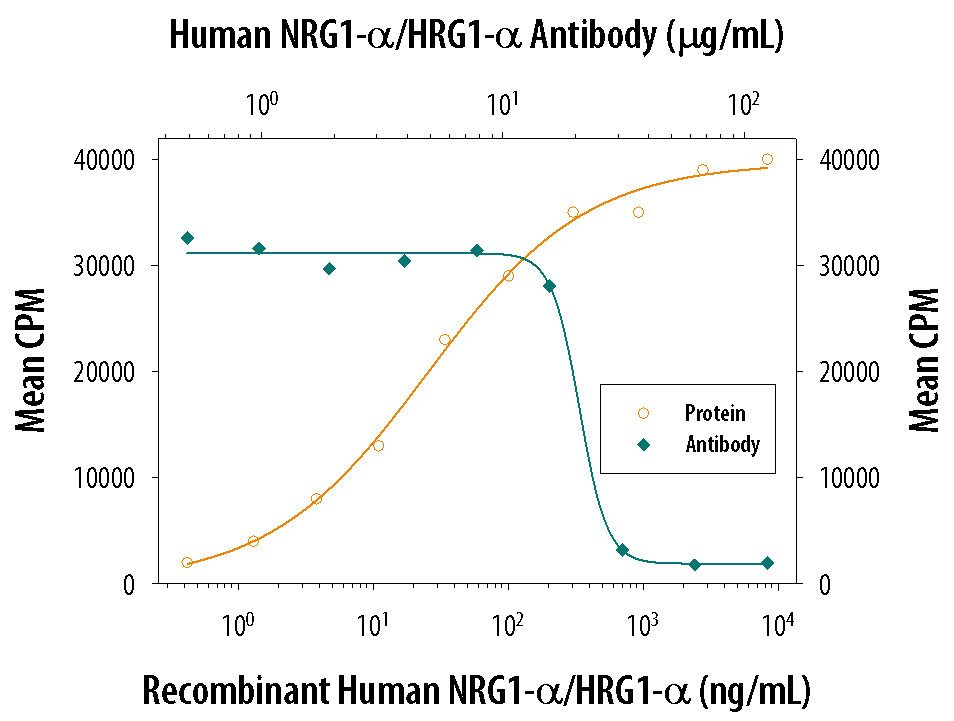Human NRG1‑ alpha /HRG1‑ alpha EGF Domain Antibody
Human NRG1‑ alpha /HRG1‑ alpha EGF Domain Antibody Summary
Ser177-Lys241
Accession # Q7RTV8
Applications
Please Note: Optimal dilutions should be determined by each laboratory for each application. General Protocols are available in the Technical Information section on our website.
Scientific Data
 View Larger
View Larger
NRG1-alpha /HRG1-alpha in Human Breast. NRG1-a/HRG1-a was detected in paraffin-embedded sections of human breast using Goat Anti-Human NRG1-a/HRG1-a EGF Domain Antigen Affinity-purified Polyclonal Antibody (Catalog # AF-296-NA) at 15 µg/mL overnight at 4 °C. Tissue was stained using the Anti-Goat HRP-AEC Cell & Tissue Staining Kit (red; Catalog # CTS009) and counterstained with hematoxylin (blue). View our protocol for Chromogenic IHC Staining of Paraffin-embedded Tissue Sections.
 View Larger
View Larger
Cell Proliferation Induced by NRG1‑ alpha /HRG1‑ alpha and Neutralization by Human NRG1‑ alpha /HRG1‑ alpha Antibody. Recombinant Human NRG1-a/HRG1-a EGF Domain (Catalog # 296-HR) stimulates proliferation in the MCF-7 human breast cancer cell line in a dose-dependent manner (orange line). Proliferation elicited by Recombinant Human NRG1-a/HRG1-a EGF Domain (125 ng/mL) is neutralized (green line) by increasing concentrations of Human NRG1-a/HRG1-a EGF Domain Antigen Affinity-purified Polyclonal Antibody (Catalog # AF-296-NA). The ND50 is typically 7-30 µg/mL.
Reconstitution Calculator
Preparation and Storage
- 12 months from date of receipt, -20 to -70 °C as supplied.
- 1 month, 2 to 8 °C under sterile conditions after reconstitution.
- 6 months, -20 to -70 °C under sterile conditions after reconstitution.
Background: Neuregulin-1 alpha/NRG1 alpha
The neuregulin family of structurally related glycoproteins comprises products from four distinct but related genes, Nrg-1, Nrg-2, Nrg-3, and Nrg-4. Through alternative splicing or the use of alternative promoters, Nrg-1 encodes more than 14 soluble or transmembrane proteins. The extracellular domain of the transmembrane NRG1 isoforms can be proteolytically cleaved to release soluble growth factors. The alpha - or beta -splice variants differ in their C-terminal region. All NRG1 isoforms contain an EGF-like domain that is required for their direct binding to the ErbB3 or ErbB4 receptor tyrosine kinases. The ErbB3 or ErbB4 subsequently recruits and heterodimerizes with ErbB2, resulting in tyrosine phosphorylation and NRG1 signaling. NRG1 isoforms can be classified into three major subtypes. Type I (Neu Differentiation Factor, NDF; Heregulin, HRG; Acetylcholine Receptor Inducing Activity, ARIA) and type II (Glial Growth Factor, GGF). NRG1s have an immunoglobulin (Ig)-like domain N‑terminal to the EGF-like domain. Type I NRG1s differ from type II NRG1s by having a glycosylation-rich domain between the Ig-like and the EGF-like domains. Type III NRG1 (Sensory and Motor neuron-Derived Factor) lacks the Ig-like domain but has a cysteine rich domain (CRD) instead. NRG1 isoforms show distinct spatial and temporal expression patterns. These proteins play important roles during development of both the nervous system and the heart. They have been shown to regulate the selective expression of neurotransmitter receptors in neurons and at the neuromuscular junction, and to promote the differentiation and development of Schwann cells from neural crest stem cells. NRG1s have also been shown to be involved in the establishment of the oligodendroglial lineage.
- Lemke, G. (2006) Science STKE 325:pe11.
- Esper, R.M. et al. (2006) Brain Res. Brain Res. Rev. 51:161.
- Tosato, S. et al. (2005) Schizophr. Bull. 31:613.
Product Datasheets
Citations for Human NRG1‑ alpha /HRG1‑ alpha EGF Domain Antibody
R&D Systems personnel manually curate a database that contains references using R&D Systems products. The data collected includes not only links to publications in PubMed, but also provides information about sample types, species, and experimental conditions.
5
Citations: Showing 1 - 5
Filter your results:
Filter by:
-
Anti-Trop2 blockade enhances the therapeutic efficacy of ErbB3 inhibition in head and neck squamous cell carcinoma
Authors: N Redlich, AM Robinson, KP Nickel, AP Stein, DL Wheeler, DR Adkins, R Uppaluri, RJ Kimple, BA Van Tine, LS Michel
Cell Death Dis, 2018-01-05;9(1):5.
Species: Xenograft
Sample Types: Tissue Homogenates
Applications: Western Blot -
Type I neuregulin1? is a novel local mediator to suppress hepatic gluconeogenesis in mice
Authors: T Arai, Y Ono, Y Arimura, K Sayama, T Suzuki, S Shinjo, M Kanai, SI Abe, K Semba, N Goda
Sci Rep, 2017-02-20;7(0):42959.
Species: Mouse
Sample Types: Tissue Homogenates
Applications: Western Blot -
Neuregulin autocrine signaling promotes self-renewal of breast tumor-initiating cells by triggering HER2/HER3 activation.
Authors: Lee, Cleo Yi-, Lin, Yuan, Bratman, Scott V, Feng, Weiguo, Kuo, Angera H, Scheeren, Ferenc A, Engreitz, Jesse M, Varma, Sushama, West, Robert B, Diehn, Maximili
Cancer Res, 2013-10-31;74(1):341-52.
Species: Mouse
Sample Types: Whole Cells
Applications: Neutralization -
Glial growth factor 2 promotes functional recovery with treatment initiated up to 7 days after permanent focal ischemic stroke.
Authors: Iaci JF, Ganguly A, Finklestein SP, Parry TJ, Ren J, Saha S, Sietsma DK, Srinivas M, Vecchione AM, Caggiano AO
Neuropharmacology, 2010-08-04;59(7):640-9.
Species: Human
Sample Types: Recombinant Protein
Applications: Western Blot -
HER family receptor abnormalities in lung cancer brain metastases and corresponding primary tumors.
Authors: Sun M, Behrens C, Feng L, Ozburn N, Tang X, Yin G, Komaki R, Varella-Garcia M, Hong WK, Aldape KD, Wistuba II
Clin. Cancer Res., 2009-07-21;15(15):4829-37.
Species: Human
Sample Types: Whole Tissue
Applications: IHC-P
FAQs
No product specific FAQs exist for this product, however you may
View all Antibody FAQsReviews for Human NRG1‑ alpha /HRG1‑ alpha EGF Domain Antibody
There are currently no reviews for this product. Be the first to review Human NRG1‑ alpha /HRG1‑ alpha EGF Domain Antibody and earn rewards!
Have you used Human NRG1‑ alpha /HRG1‑ alpha EGF Domain Antibody?
Submit a review and receive an Amazon gift card.
$25/€18/£15/$25CAN/¥75 Yuan/¥2500 Yen for a review with an image
$10/€7/£6/$10 CAD/¥70 Yuan/¥1110 Yen for a review without an image

